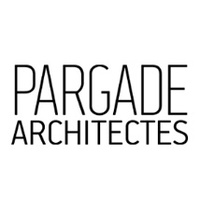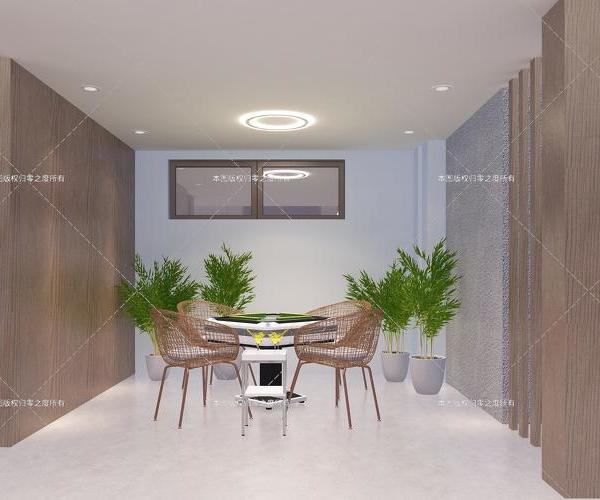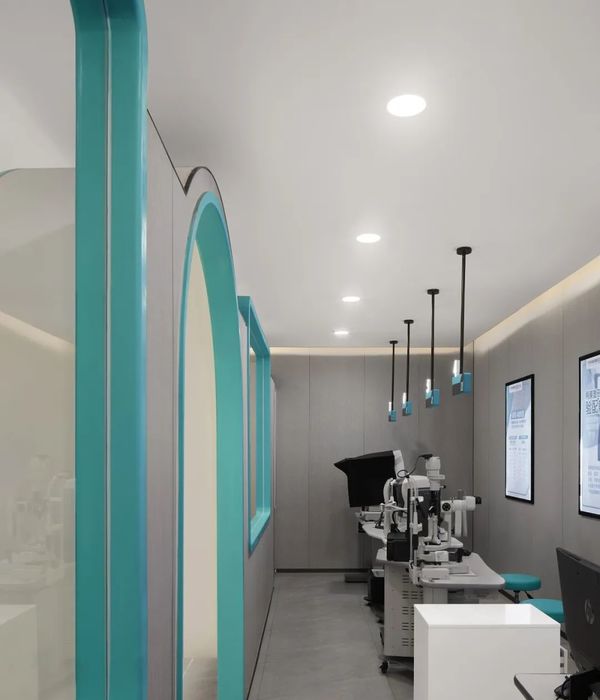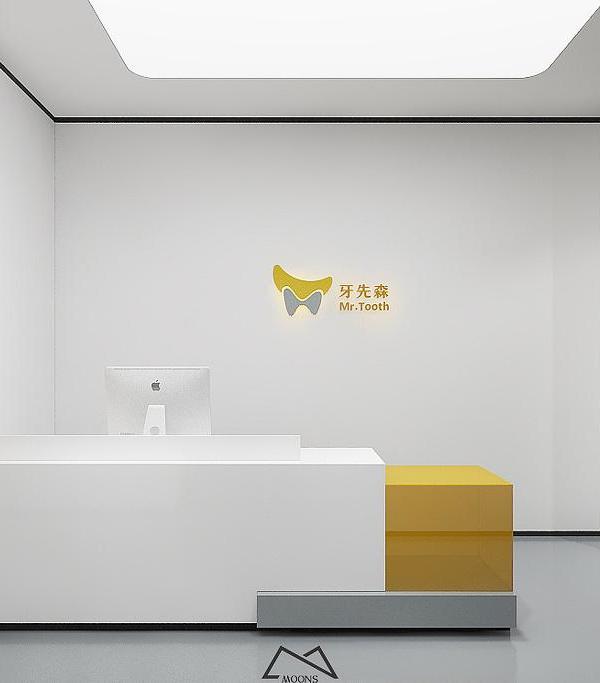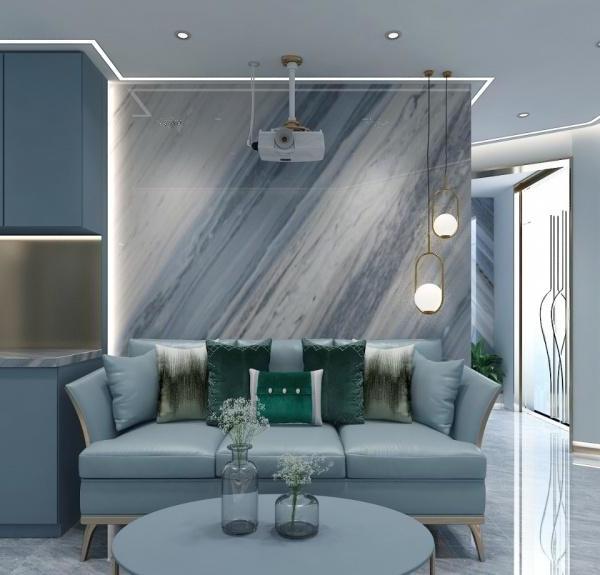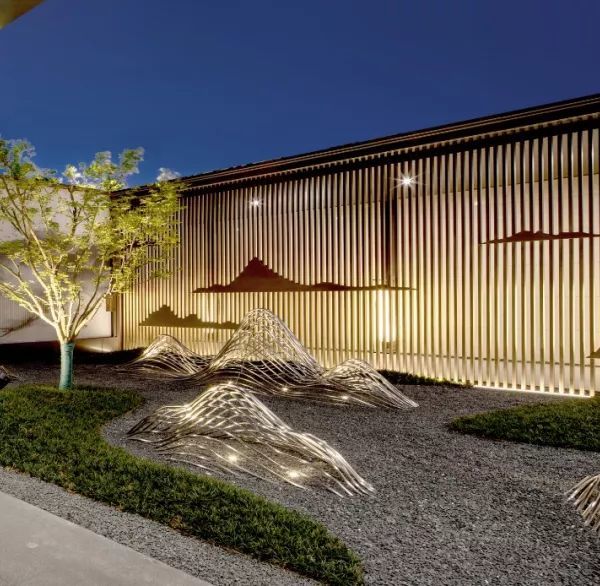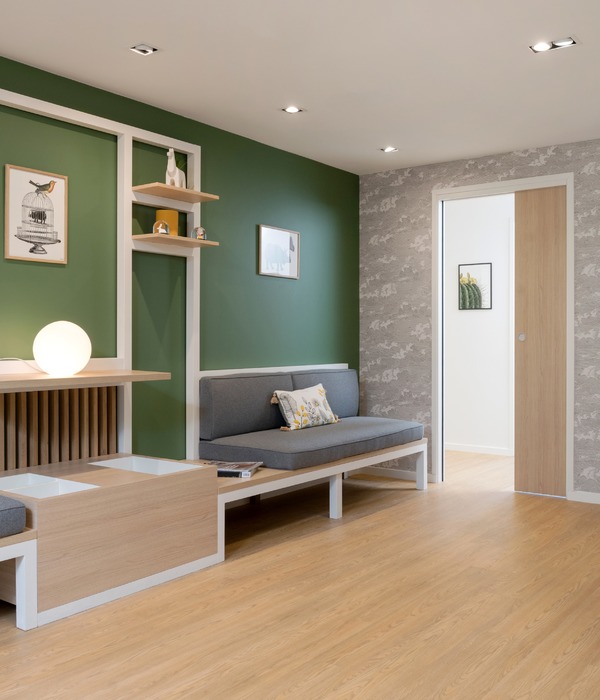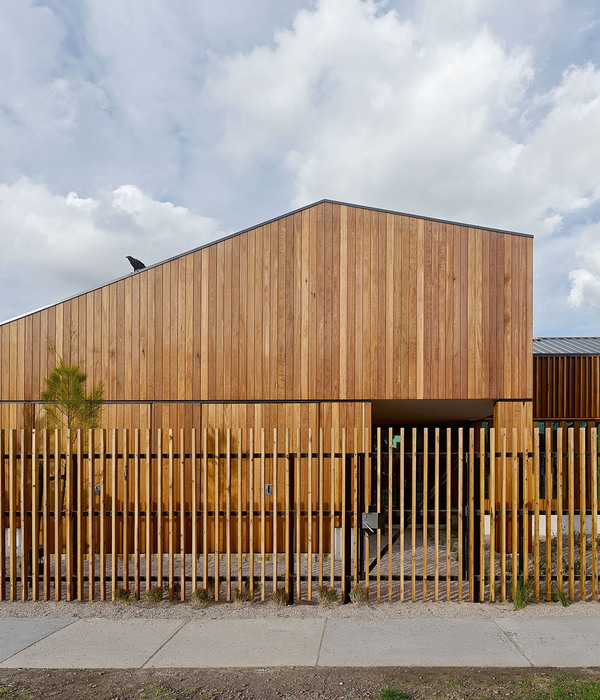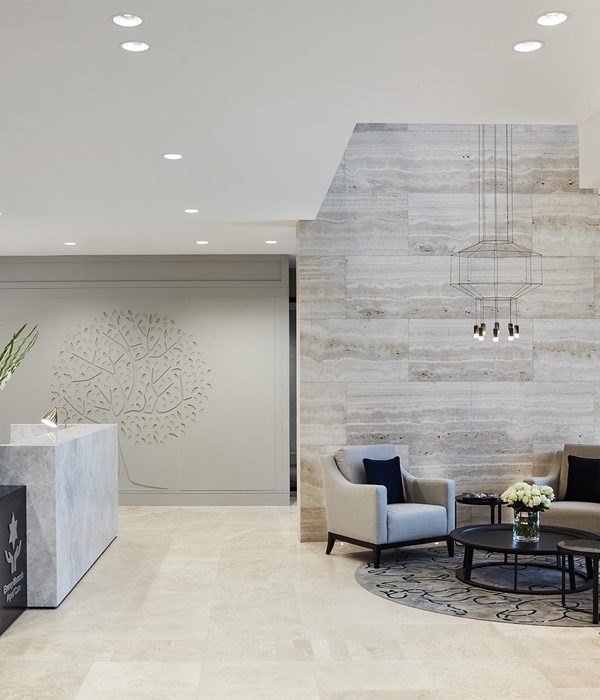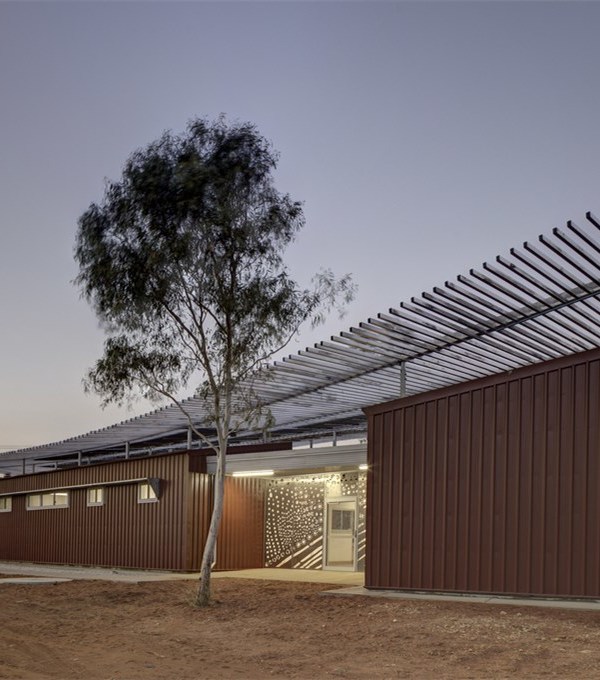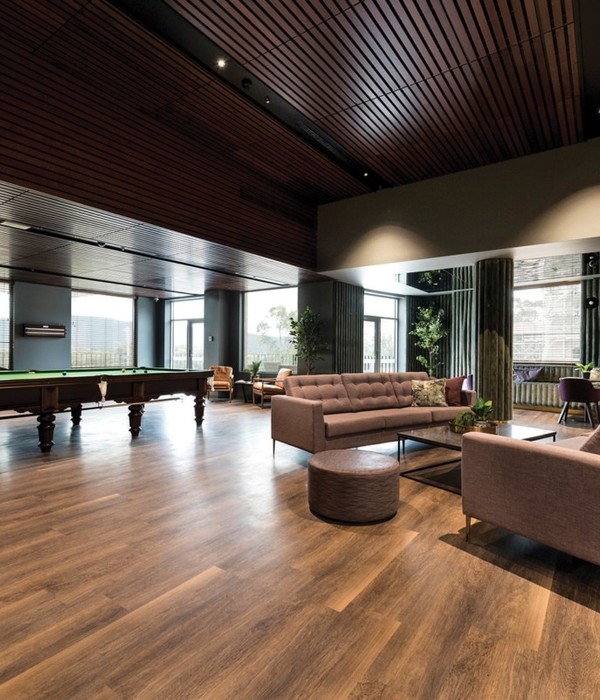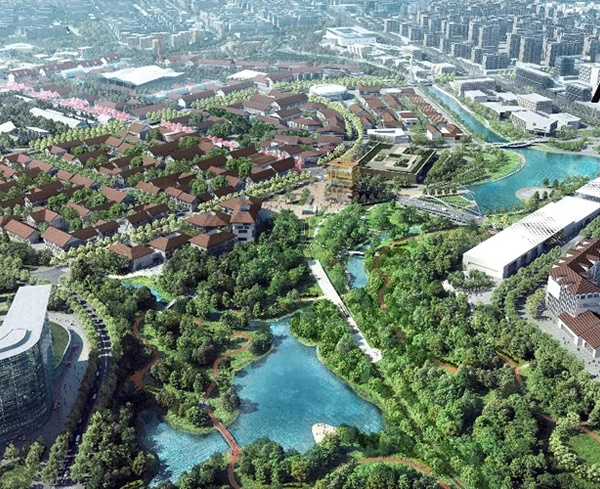法国北部私人医院,现代舒适的治疗空间
这个位于法国北部的私人医院于2012年9月27日正式对外开放,是当地提升现代高质医疗项目的一部分,它作为城市中诊所的一个补充结构,提供完整的住院设施和多学科的治疗部门。该医院一共有225个床位,其中42个妇产科床位。除此之外还有外科,理疗,放射,化疗等等多个部门。

医院处于城郊住宅区和商业区之间的大片绿化带上,其体量和规模与周围建筑协调。建筑外表皮所用砖的色彩契合法国北部居民常用的石板。窗户玻璃上有着丝网印刷的花卉图案。地面层有一个与花园融为一体的玻璃长廊。
建筑对提升医院形象起到了重要的作用。医院展现出高效,安全同时让人愉悦的一面。这里强调归属感和舒适感并为病人提供个性化的服务。入口空间是一个两层高的宽敞温馨空间。室内外的联系让室外美景渗透进室内各个空间。
色彩是医院空间组织的重要元素。淡淡的柔和色彩让环境变得宁静,并通过粉色,蓝色,绿色等色彩营造出对比效果。色块使得建筑内部更有活力,同时创建出热情友好的气氛。
医院的空间被紧凑的组织在矩形体量之中,简单的几何体量为医院部分布置提供了相当大的灵活性,并减少不必要的交通路径,通过水平和垂直交通有效的进行运转。

new private hospital in Villeneuve d’asch by Jean-Philippe Pargade
The new private hospital in Villeneuve d’Ascq (northern France) is a response to the regional modernisation programme aiming to improve the quality of health care. The facility acts as a structuring element in synergy with the clinics already present around the city of Lille.
The hospital provides multidisciplinary care for outpatients and patients requiring full hospitalisation. Its programme includes 225 beds and medical, surgical and obstetrics units as well as a medico-technical centre. It has a large 42-bed maternity unit, 10 operating theatres as well as radiotherapy, chemotherapy and nuclear medicine units.
In 2007, the Jean-Philippe Pargade agency was named winner of the competition launched by Générale de Santé. The team included EGIS Nord, an all-trades engineering firm, and Martin & Guiheneuf, a firm specialised in quantity surveying services.
The hospital has a net plan area of 22,681 m². The overall cost of the works represents €41 million (2012 value).
Operational since 26 June 2012, the new hospital was inaugurated on 27 September 2012.
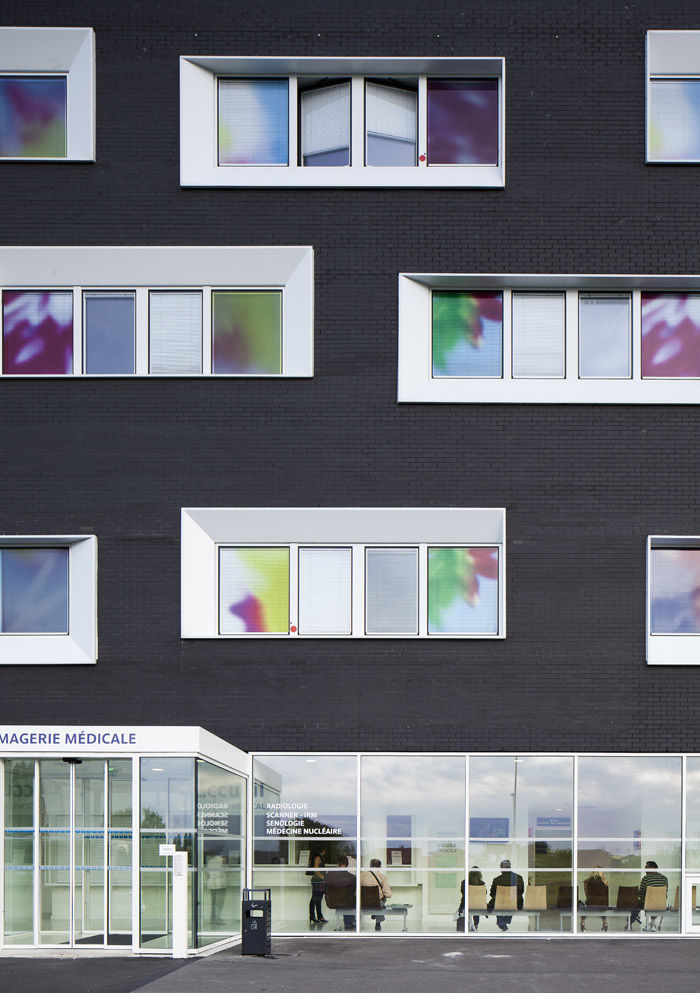
Architectural approach
A landmark on the outskirts of Lille
The new private hospital in Villeneuve d’Ascq covers an area recuperated from uncultivated farmland located in the new Recueil district urbanisation zone. It is a local health centre lying between a residential district and a commercial activity area. The same architectural style unifies all the programme elements and allows the new facility to stand out as a contemporary project located in the greater Lille area. The project by the Pargade agency is designed as a simple volume based on a rectangular plan providing a harmonious transition between the scale of the nearby commercial buildings and that of the houses located in the adjoining suburban fabric. Set back from the street alignment, the project incorporates a garden giving onto the entrance esplanade. The logistics area is positioned to the rear of the building and the car parks to the sides. This allows the hospital to open onto a large green space reminiscent of a convent layout.
Contemporary and contextual aesthetics
The building’s envelope is handled as a pictorial composition. The slate coloured brick facades reinterpret a vernacular architecture specific to northern France. These outer walls incorporate large windows treated as a patterned design with incorporated screen printed floral motifs. This composition is emphasised by a glazed gallery on the ground floor that extends through the hall and opens out over the garden space.
Taken together, the project creates an interplay of graphic forms that catches the eye. The idea is break away from the tradition image held by hospitals by providing a contemporary sculptural object while remaining within a contextual vocabulary recognisable by local residents.
Enhancing the image held by a hospital
Architecture has a major role to play in enhancing the image held by hospitals. As a symbolic setting, the hospital simultaneously needs to be welcoming and reassuring as well as efficient and safe.
Particular emphasis is placed on reception and comfort to ensure that each patient is looked after in a personalised and adapted manner. The entrance hall is similar to a hotel lobby, providing a monumental volume rising up over two levels and creating a welcoming and generous space.
The heart of the building places emphasis on transparency and simultaneously provides views over the outdoor landscape and the various indoor spaces. Glazed galleries provide transversal links between patient care units and contribute to the efficient running of the hospital.
The geometric and compact volume is pierced by openings in the form of small garden patios that open the building onto the surrounding environment. These occasional voids bring natural light into the heart of the floor levels and adapt to potential programmatic constraints.
Colour
The colours used in the interior spaces represent a fundamental component in the hospital’s spatial organisation. Soft, pale colour tones are privileged to contribute to the serenity of the surroundings. Alternating solid tints making use of pinks, blues and greens cover the surfaces, creating contrast effects. Movements through the building reveal graphic compositions, associations and paintings reaching out into the space. The colours contribute to humanising the various functions and create a warm and friendly atmosphere.
A model of functionality
The overall organisation of the facility presents itself as a model of hospital functionality. It is based on a system of floor levels favouring shared means, proximity and visibility between departments. The rectangular geometry takes the form of a compact comb and is designed to easily permit the creation of vertical extensions without any need for additional building works. This particularly applies to the operating theatres lying below the plantrooms and the ground floor consultation and medical imagery areas. This simple geometry provides considerable organisational flexibility. It rationalises circulation areas and reduces movements by favouring horizontal juxtapositions. The organisational system ensures that the hospital building is able to adapt to any future programmatic modifications.

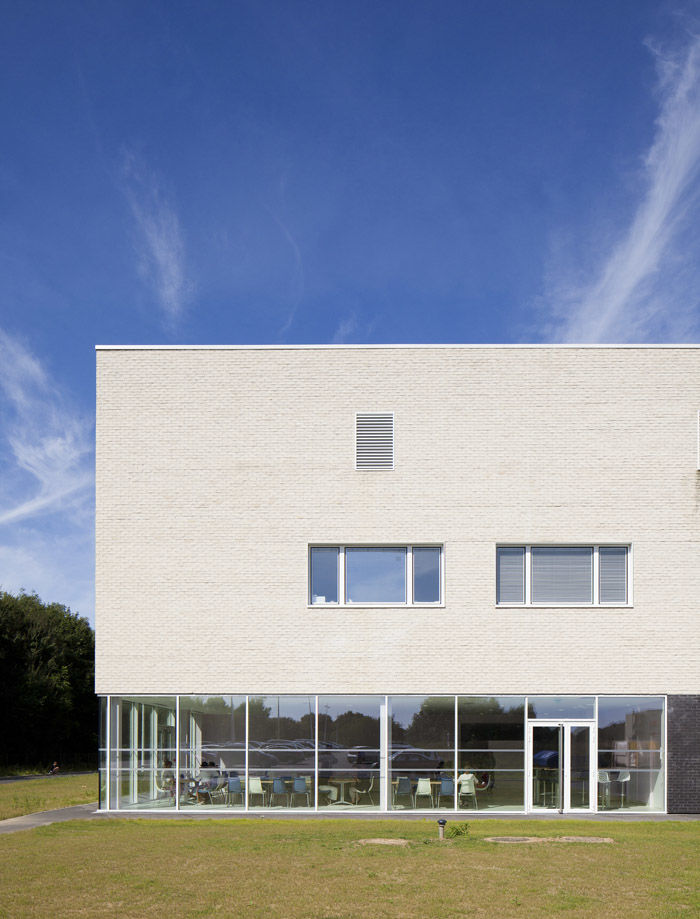
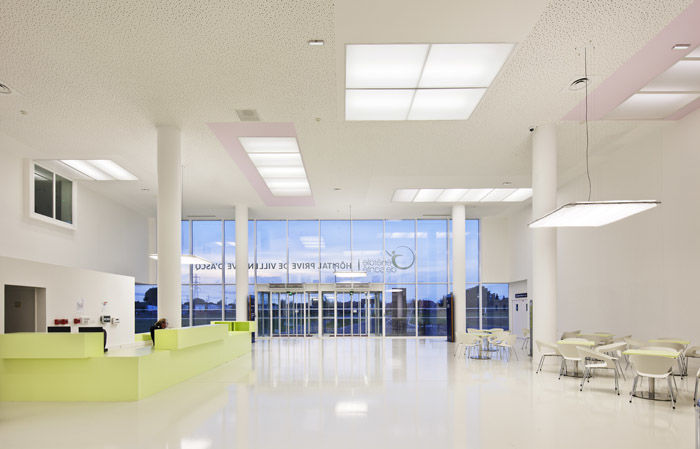
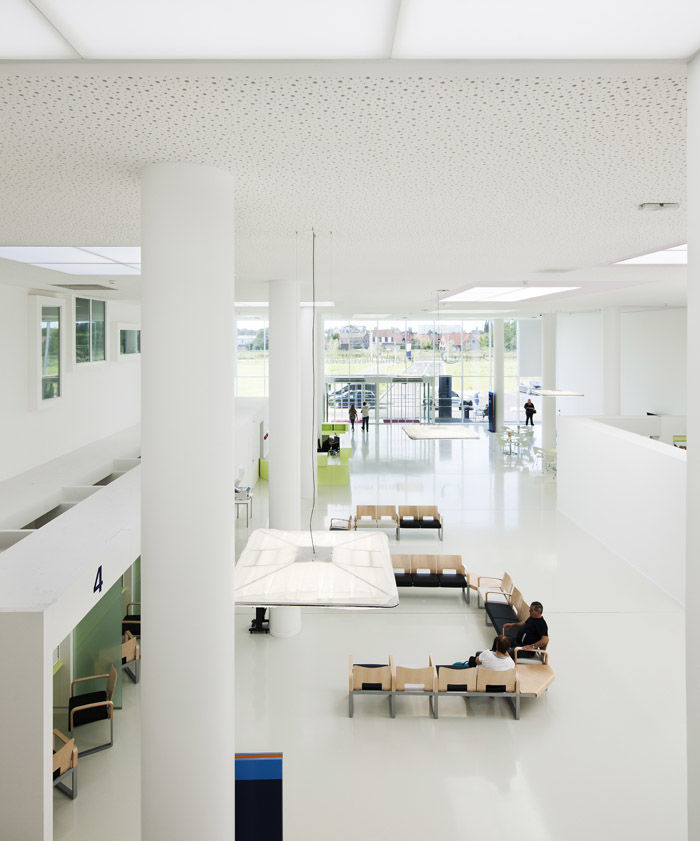


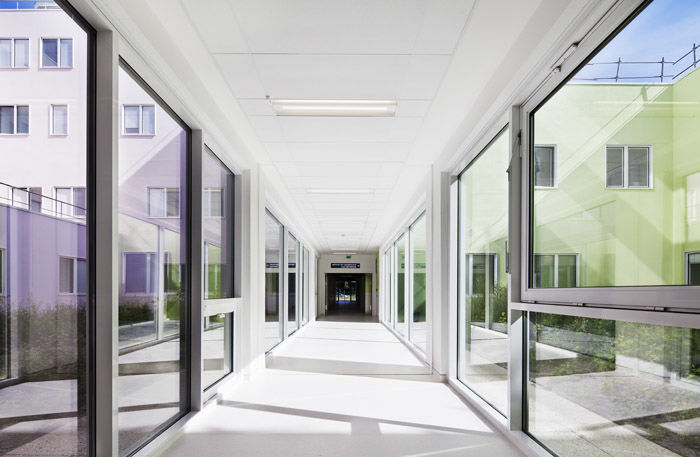
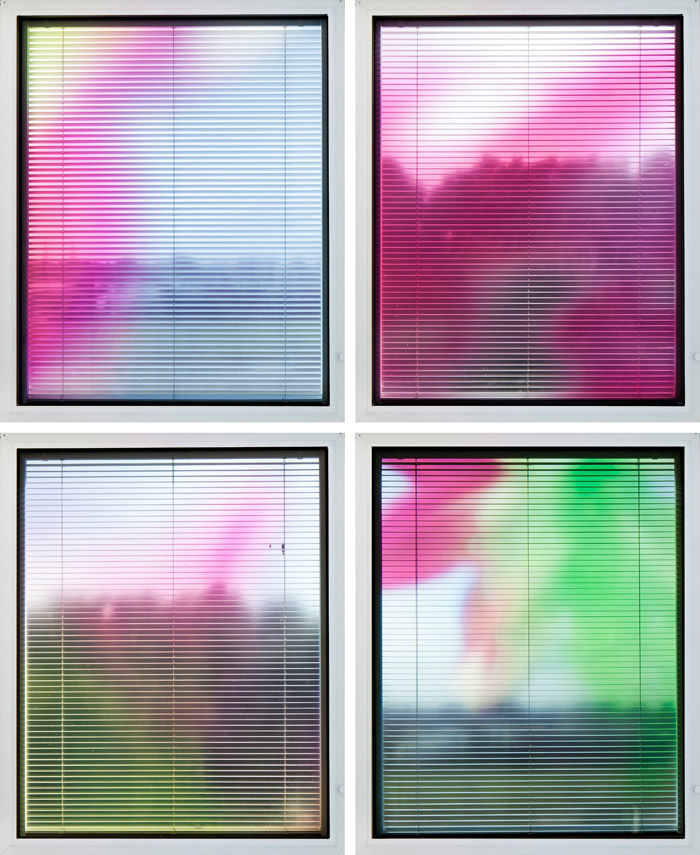
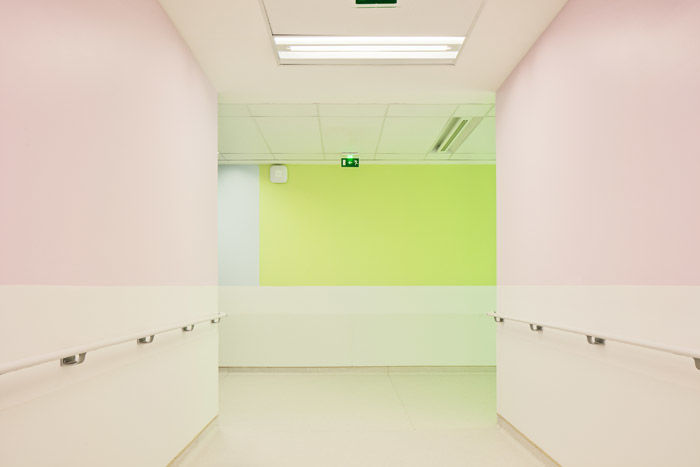
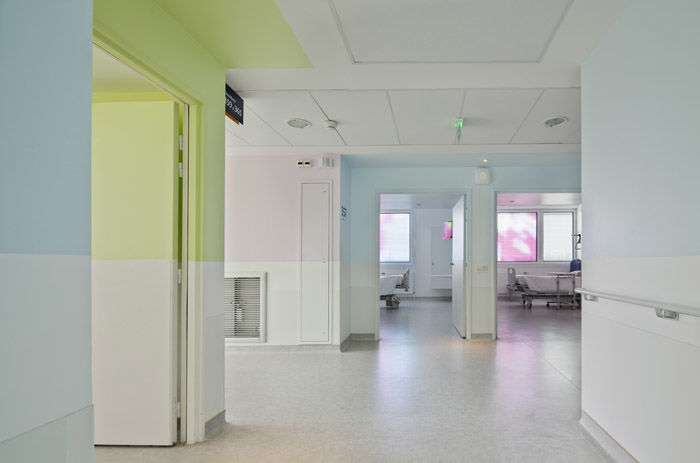
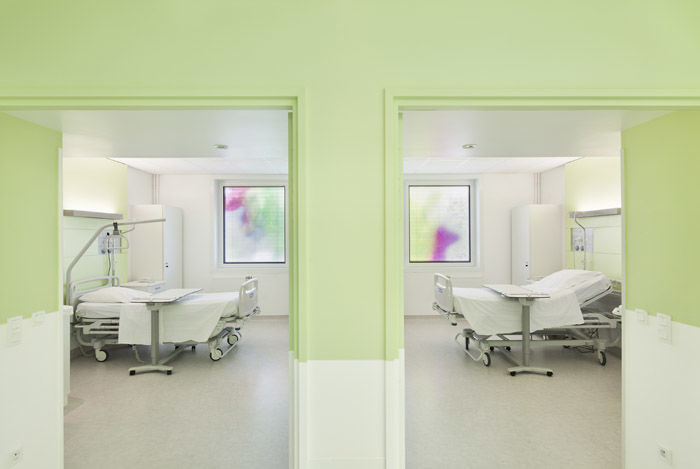
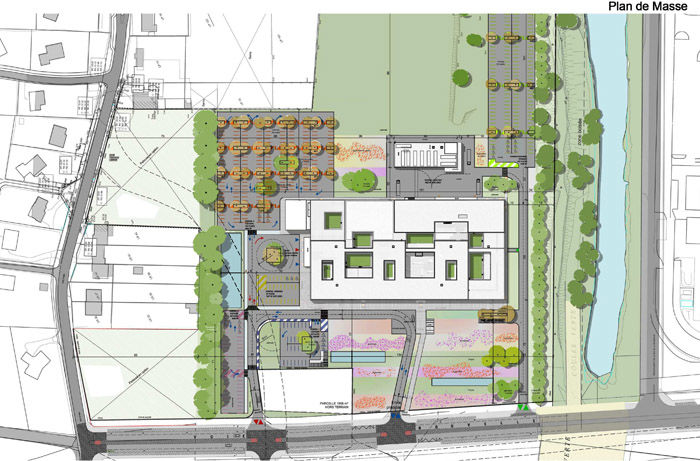
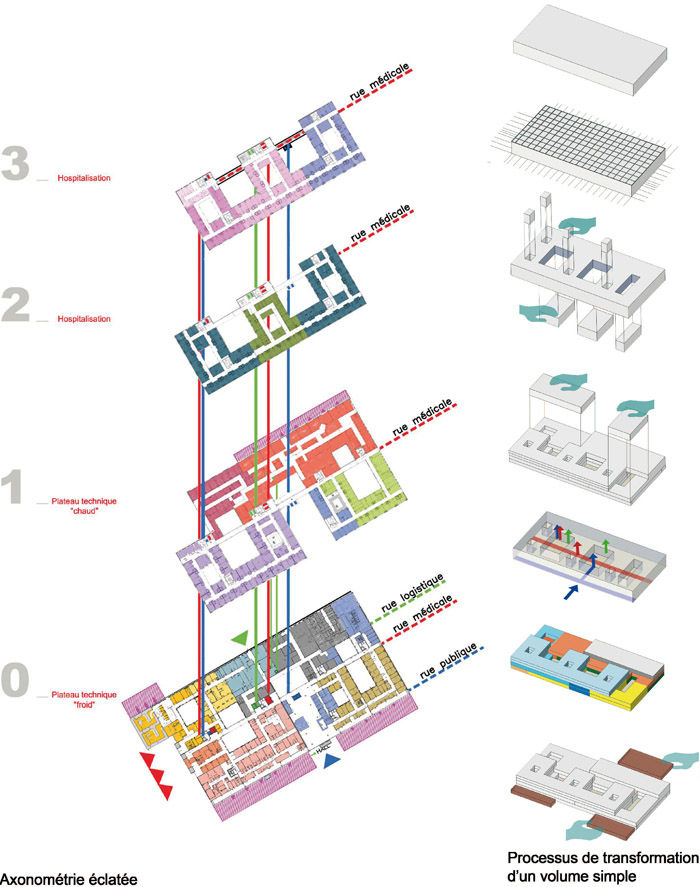
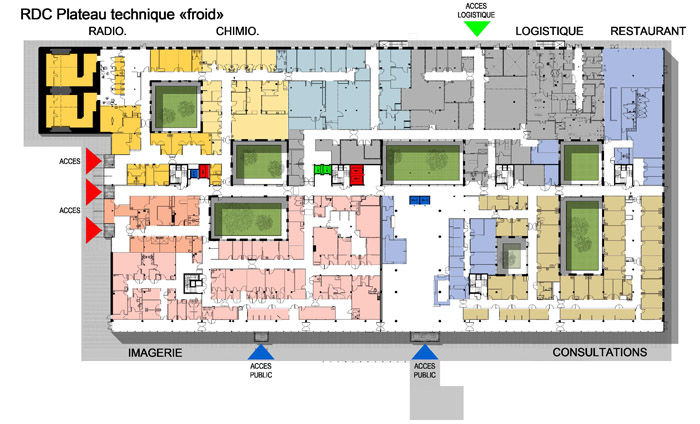
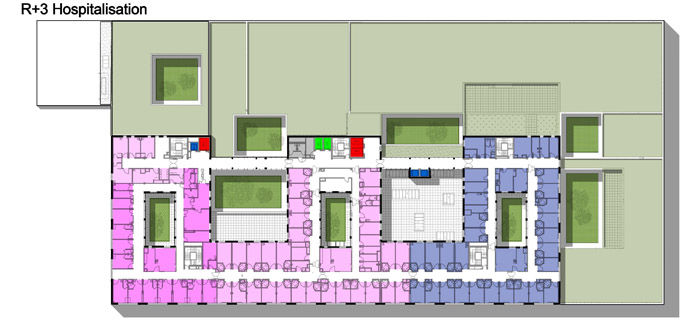

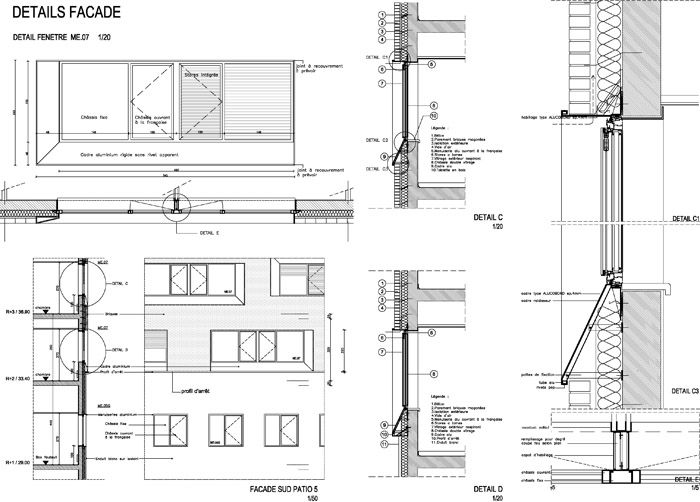
Here’s some more information from the Jean-Philippe Pargade Architecte:Jean-Philippe Pargade graduated as an architect from the UP6 school of architecture in Paris and as a town planner from the Ecole Nationale des Ponts et Chaussées. He created his agency in Paris in 1980 and works in all fields of architecture and town planning. Among his many projects are a number of acclaimed buildings such as the Sarthe-et-Loir health centre in Bailleul, the French embassy in Warsaw, the biology centre in the Croix-Rousse hospital in Lyon, 37 housing units in Paris Seine Rive- Gauche, and the biology research centre for the CNRS in Toulouse.
For a number of years, Jean-Philippe Pargade has involved himself in the challenges represented by the hospital environment. How to design tomorrow’s hospitals, health-based workplaces and research centres? How to anticipate and comply with the vast number of constraints inherent in hospital design? How to anticipate potential obsolescence, future changes, the need to humanise patient and staff environments? As well as these points, it is also necessary to anticipate the advances now being made in science and medicine and which need to be taken into consideration at all moments during the design and construction of a hospital facility. Perfect siteintegration, optimised spatial organisation, immediate efficiency, extended flexibility, guaranteed safety and security and, above all, a high level of sensitivity are fundamental factors in ensuring the successful design of a hospital.
In addition to this, Jean-Philippe Pargade lays claim to a made-to-measure architecture that personalises and develops the poetry of the settings. In this way, he is able to create agreeable settings that encourage free exchange while allowing people to retain their identity. This is translated by the use of aesthetics, compactness,generous volumes opening out over landscaped gardens and an awareness of the importance of cost control and sustainability, as well as an understanding of the need for the architecture to be both relaxing and artistic.
Currently, the Jean-Philippe Pargade agency is working on several large operations: the extension to the Kremlin Bicêtre faculty of medicine, the Bienvenüe space for the Marne-la-Vallée scientific and technical centre, the industrial Siaap campus in Achères and the extension and renovation of the Saint-Joseph hospital in Marseille. It is also one of the three architectural agencies shortlisted for the Centre Hospitalier Princesse Grace de Monaco competition (submission in January 2013).
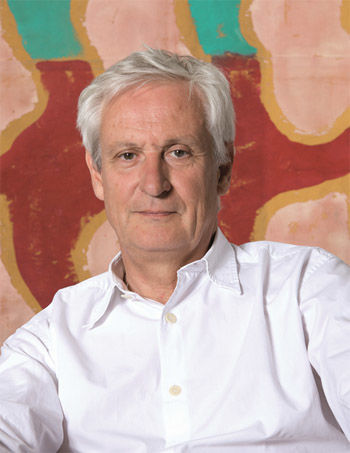
Project data
Project name Hôpital Privé de Villeneuve d’Ascq
Address 20, avenue de la Reconnaissance – 59657 Villeneuve d’Ascq – France
Client GENERALE DE SANTE, ICADE
Project management
Jean-Philippe Pargade (lead architect)Egis (all-trades engineers)Martin et Guiheneuf (surveyors)Programme 225 beds and medical, surgical and obstetrics units, medico-technical
centre
Surfaces 22,681 m² (net plan area) – 13,297 m² (usable floor area)Programme Winning project: 2007 – Handover: June 2012Total cost €41 M excl. VAT (2012 value)Contractors SOGEA CARONI (structural works, external doors and windows,waterproofing, metalwork), EUROVIA (external works, green spaces), EETH (HVAC),MGC (plumbing), EETN (electricity), PLATRES MODERNES (plaster partitions),ROUX FRERES (timber joinery), VALLEE (false ceilings, painting, flexible floorcoverings)Main products VANDERSANDEN (façade bricks); R’PURE (air-permeable frames) by
Wicona; ALUCOBOND (window frames); ACE GLASS (coloured films incorporated
into glazing); MIR O DAL (translucent ceilings)Photo credits ©Luc Boegly
Biography
Pargade, architect and town planner
MORE:Jean-Philippe Pargade Architecte
,更多请至:

